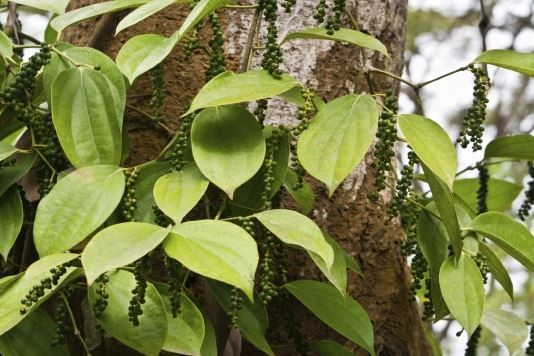How some of our favourite foods are grown

Would you recognise what these well-known fruit and vegetables were if you saw them 'in the wild'?
In a society where we're increasingly distanced from the means by which our food travels to the table, it's become very possible to not even know what a plant looks like while it's growing.
Do you know what the plant above is, for example? I'm a little ashamed to admit that this one is a relatively recent discovery for me, as I had naively assumed for years that black pepper was some kind of seed from a particular chilli pepper plant.
I was wrong of course. That's black pepper.
What else might come as a surprise to some of us?
Brussels sprouts
On the stalk, there's a resemblance to sleigh bells. No wonder they're a Christmas favourite. But you don't tend to see them presented like this in the supermarket, though you probably will in local fruit and veg markets.
Cantaloupe
When you think about it, it makes a lot of sense that melons grow on the floor, as a tree would have to be pretty strong to hold up fruit that weigh up to a few kilos each.
Watermelon
Watermelons are, like cantaloupes, a trailing plant that grow along the ground – which must make keeping pests off a crop a real difficulty for farmers. Some cultivars of watermelon can grow up to weights of 100kg or more!
Peanuts
This one is fairly well known, but if you don't know, it may come as a surprise. Peanuts grow underground in root clusters, and they're technically legumes, like beans and peas, not nuts.
Think about that the next time you pick up a bag of peanuts to go with your pint.
Pineapple
Pineapple farms look completely ridiculous: little spiky shrubs with a fruit balancing upright on top of a stem in the middle. The first time I saw this plant, I assumed it was a wind-up. But it's not.
They look even more surreal in numbers, as below on this pineapple farm in Ghana.
Credit: hiyori13
Cashew nuts
Cashew nuts are expensive compared to other nuts, and there's a good reason for that. Instead of growing directly on the tree, they grow in pods on the end of a cashew apple.
There's something strangely alien about these fruit, which are also edible but difficult to transport far. It is pulped into juice drinks in local communities and used to make alcoholic liquor in some places.
Kiwi fruit
Kiwi fruit grow on a vine, like grapes. But their weight means that the vine can't support an awful lot of them, so in commercial operations the plants are supported by a purpose-built metal or wooden structure to give them support and the potential for a much larger yield.
Saffron
Saffron is expensive because it can only be produced in relatively small quantities and it is labour intensive to harvest. Saffron is picked from the flowers of the saffron crocus. It is the red 'threads' that are emerging from the centre of the flower, as you can see below.
These must be painstakingly collected by hand so as not to damage the precious strands.
Vanilla
You won't be surprised to learn that vanilla comes from a pod, but you might find it interesting to learn that the plant that the pods grow on are in fact orchids. The pods are dried before being sold.
Did you know how these plants grew? Are there any others that you think might surprise us? Let us know in the Comments below.
You might also like:
How to grow your own salad leaves
Comments
Be the first to comment
Do you want to comment on this article? You need to be signed in for this feature